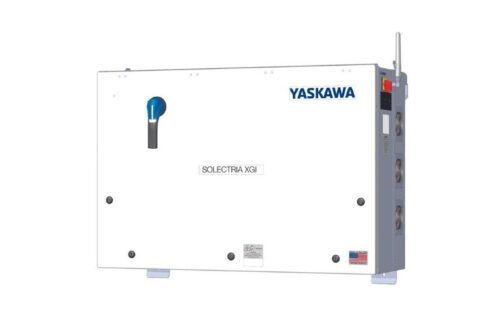 Yaskawa Solectria Solar announced its new SOLECTRIA XGI 1500-250 lineup of utility-interactive inverters that feature higher power and DC oversizing ratios from 2.0-2.86.
Yaskawa Solectria Solar announced its new SOLECTRIA XGI 1500-250 lineup of utility-interactive inverters that feature higher power and DC oversizing ratios from 2.0-2.86.
The flagship model, with its rating of 250-kW and 600-VAC 3-phase output, is joined by models with 480-VAC 3-phase output, and select models with user-adjustable reactive- power overhead. Multi-inverter racks, factory assembled and tested, provide 1-2 MW power building blocks for large projects. In addition the SOLECTRIA XGI 1500-250 inverters have undergone advanced cybersecurity analysis to ensure they are the secure and reliable.
The SOLECTRIA XGI 1500 inverters are Made in the USA with global components at the Yaskawa America factory in Buffalo Grove, Illinois. XGI 1500 and XGI 1000 inverters are designed and manufactured in the USA and are Buy America Act (BAA) compliant.
“We strive to stay at the leading edge in PV inverter product design. The new SOLECTRIA XGI 1500-250 series combines the most important elements that our customers have been asking for: increased power output, AC voltage options, high DC oversizing capability and advanced cybersecurity,” said Miles C. Russell, director of product management at Yaskawa Solectria Solar. “Now we are able to deliver on these exciting advancements and continue the strong tradition of Yaskawa quality and reliability.”
News item from Yaskawa Solectria Solar





A 2.0 up to 2.86 to 1 D.C. to A.C. ratio allows one to design a “serial” solar PV farm that would use very large-scale energy storage in a manner that could create the design of solar PV farms that would charge throughout the solar PV harvest day, store this energy and dispatch it in a modular fashion, (1 to 2MW) power blocks to matrix into a grid demand system that could be designed for 250MWh for 10 hours of operation, or some other demand capacity like 100MWh for 25 hours. Now one can get rid of some of those natural gas Peaker plants as capacity dispatch can be handled by solar PV and utility scale energy storage. The Peaker plants are usually a run capacity of around 6% to 10% over a (year), solar PV and energy storage can be designed and used in a 24/7 fashion as daytime generation and nighttime dispatch or some form of energy shuttling for a day ahead electric grid.